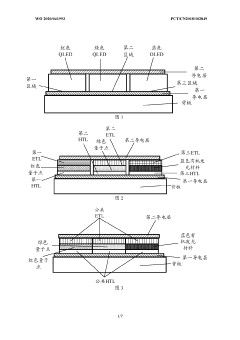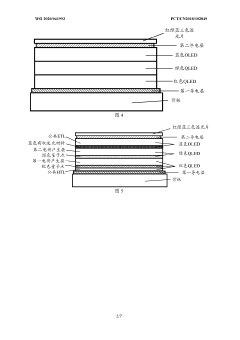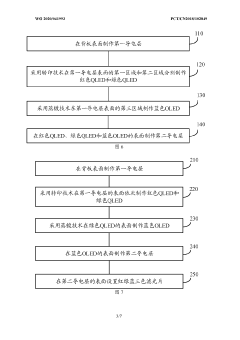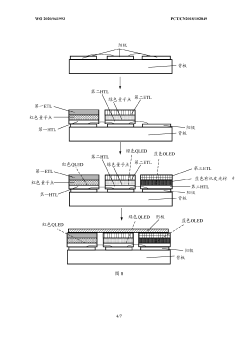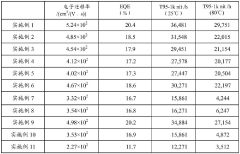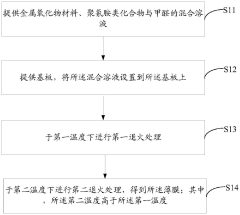ULED vs QLED: Analyzing Lifespan and Durability
JUN 20, 20259 MIN READ
Generate Your Research Report Instantly with AI Agent
Patsnap Eureka helps you evaluate technical feasibility & market potential.
ULED and QLED Background and Objectives
ULED (Ultra Light Emitting Diode) and QLED (Quantum Dot Light Emitting Diode) represent two cutting-edge display technologies that have emerged as potential successors to traditional LED and OLED displays. These technologies have garnered significant attention in the consumer electronics industry due to their promise of enhanced picture quality, energy efficiency, and durability.
The evolution of display technology has been driven by the constant pursuit of better image quality, longer lifespan, and improved energy efficiency. ULED, developed by Hisense, builds upon traditional LED technology by incorporating advanced local dimming techniques and proprietary image processing algorithms. QLED, pioneered by Samsung, utilizes quantum dot technology to enhance color reproduction and brightness.
Both ULED and QLED aim to address the limitations of existing display technologies. ULED focuses on improving contrast ratios and black levels, while QLED emphasizes color accuracy and brightness. The primary objective of these technologies is to provide consumers with a superior viewing experience that rivals or surpasses that of OLED displays, while potentially offering better longevity and resistance to image retention issues.
The development of ULED and QLED is closely tied to the increasing demand for larger, higher-resolution displays in both consumer and professional markets. As 4K and 8K content becomes more prevalent, there is a growing need for display technologies that can fully leverage these high-resolution formats while maintaining color accuracy and contrast.
In terms of technological progression, ULED and QLED represent different approaches to achieving similar goals. ULED relies on enhancing existing LED technology through software and hardware optimizations, while QLED introduces a new layer of quantum dot material to fundamentally alter how light is produced and managed within the display.
The lifespan and durability of these technologies are crucial factors in their adoption and long-term success. Both ULED and QLED claim to offer improved longevity compared to OLED displays, which are known to be susceptible to burn-in over time. However, the exact extent of this improvement and the long-term performance of these technologies in real-world conditions remain subjects of ongoing research and debate within the industry.
As the display market continues to evolve, ULED and QLED are positioned as potential solutions to meet the increasing demands of consumers and professionals alike. The analysis of their lifespan and durability is not only critical for end-users but also for manufacturers and retailers in determining the future direction of display technology development and marketing strategies.
The evolution of display technology has been driven by the constant pursuit of better image quality, longer lifespan, and improved energy efficiency. ULED, developed by Hisense, builds upon traditional LED technology by incorporating advanced local dimming techniques and proprietary image processing algorithms. QLED, pioneered by Samsung, utilizes quantum dot technology to enhance color reproduction and brightness.
Both ULED and QLED aim to address the limitations of existing display technologies. ULED focuses on improving contrast ratios and black levels, while QLED emphasizes color accuracy and brightness. The primary objective of these technologies is to provide consumers with a superior viewing experience that rivals or surpasses that of OLED displays, while potentially offering better longevity and resistance to image retention issues.
The development of ULED and QLED is closely tied to the increasing demand for larger, higher-resolution displays in both consumer and professional markets. As 4K and 8K content becomes more prevalent, there is a growing need for display technologies that can fully leverage these high-resolution formats while maintaining color accuracy and contrast.
In terms of technological progression, ULED and QLED represent different approaches to achieving similar goals. ULED relies on enhancing existing LED technology through software and hardware optimizations, while QLED introduces a new layer of quantum dot material to fundamentally alter how light is produced and managed within the display.
The lifespan and durability of these technologies are crucial factors in their adoption and long-term success. Both ULED and QLED claim to offer improved longevity compared to OLED displays, which are known to be susceptible to burn-in over time. However, the exact extent of this improvement and the long-term performance of these technologies in real-world conditions remain subjects of ongoing research and debate within the industry.
As the display market continues to evolve, ULED and QLED are positioned as potential solutions to meet the increasing demands of consumers and professionals alike. The analysis of their lifespan and durability is not only critical for end-users but also for manufacturers and retailers in determining the future direction of display technology development and marketing strategies.
Market Demand Analysis for Advanced Display Technologies
The market demand for advanced display technologies, particularly ULED (Ultra LED) and QLED (Quantum Dot LED), has been experiencing significant growth in recent years. This surge is driven by the increasing consumer appetite for high-quality visual experiences across various applications, including home entertainment, digital signage, and professional displays.
ULED and QLED technologies have emerged as strong contenders in the premium display market, offering enhanced picture quality, color accuracy, and energy efficiency compared to traditional LED displays. The demand for these technologies is closely tied to the growing popularity of 4K and 8K resolution displays, as consumers seek more immersive viewing experiences.
In the consumer electronics sector, there is a notable shift towards larger screen sizes, particularly in the 55-inch and above category. This trend has created a fertile ground for ULED and QLED technologies, as they excel in delivering superior picture quality on larger screens. The home entertainment market, including smart TVs and gaming monitors, has been a key driver of demand for these advanced display technologies.
The commercial sector also presents significant opportunities for ULED and QLED displays. Digital signage applications in retail, hospitality, and corporate environments are increasingly adopting these technologies for their ability to deliver vibrant, high-contrast images even in brightly lit spaces. The durability and longevity of these displays make them particularly attractive for businesses looking to make long-term investments in their visual communication infrastructure.
The automotive industry is another emerging market for ULED and QLED technologies. As vehicle manufacturers focus on enhancing in-car infotainment systems and dashboard displays, there is growing interest in displays that can offer superior visibility and color accuracy under varying lighting conditions.
Market analysts project continued growth in the demand for ULED and QLED displays over the next five years. Factors contributing to this growth include declining production costs, technological advancements improving picture quality and energy efficiency, and increasing consumer awareness of display technology benefits.
However, the market also faces challenges. The ongoing competition from OLED technology, which offers superior black levels and viewing angles, continues to impact the market share of ULED and QLED displays in certain segments. Additionally, the higher cost of these advanced technologies compared to standard LED displays may limit adoption in price-sensitive markets.
ULED and QLED technologies have emerged as strong contenders in the premium display market, offering enhanced picture quality, color accuracy, and energy efficiency compared to traditional LED displays. The demand for these technologies is closely tied to the growing popularity of 4K and 8K resolution displays, as consumers seek more immersive viewing experiences.
In the consumer electronics sector, there is a notable shift towards larger screen sizes, particularly in the 55-inch and above category. This trend has created a fertile ground for ULED and QLED technologies, as they excel in delivering superior picture quality on larger screens. The home entertainment market, including smart TVs and gaming monitors, has been a key driver of demand for these advanced display technologies.
The commercial sector also presents significant opportunities for ULED and QLED displays. Digital signage applications in retail, hospitality, and corporate environments are increasingly adopting these technologies for their ability to deliver vibrant, high-contrast images even in brightly lit spaces. The durability and longevity of these displays make them particularly attractive for businesses looking to make long-term investments in their visual communication infrastructure.
The automotive industry is another emerging market for ULED and QLED technologies. As vehicle manufacturers focus on enhancing in-car infotainment systems and dashboard displays, there is growing interest in displays that can offer superior visibility and color accuracy under varying lighting conditions.
Market analysts project continued growth in the demand for ULED and QLED displays over the next five years. Factors contributing to this growth include declining production costs, technological advancements improving picture quality and energy efficiency, and increasing consumer awareness of display technology benefits.
However, the market also faces challenges. The ongoing competition from OLED technology, which offers superior black levels and viewing angles, continues to impact the market share of ULED and QLED displays in certain segments. Additionally, the higher cost of these advanced technologies compared to standard LED displays may limit adoption in price-sensitive markets.
Current State and Challenges in ULED and QLED Technologies
ULED (Ultra Light Emitting Diode) and QLED (Quantum Dot Light Emitting Diode) technologies represent the cutting edge in display technology, each offering unique advantages and facing distinct challenges in terms of lifespan and durability. The current state of these technologies reflects significant advancements, yet also highlights areas requiring further development.
ULED technology, pioneered by Hisense, utilizes a combination of quantum dot technology and proprietary light-emitting compounds to achieve enhanced brightness and color accuracy. The current generation of ULED displays boasts impressive peak brightness levels, often exceeding 1,500 nits, and can reproduce a wide color gamut covering over 90% of the DCI-P3 color space. However, ULED faces challenges in maintaining consistent performance over extended periods, with some reports indicating potential color shift and brightness degradation after prolonged use.
QLED, on the other hand, has seen widespread adoption by manufacturers like Samsung and TCL. The latest QLED displays leverage quantum dot enhancement film (QDEF) to achieve superior color volume and brightness. Current QLED panels can reach peak brightness levels of up to 2,000 nits and cover nearly 100% of the DCI-P3 color space. The primary challenge for QLED technology lies in addressing the issue of "burn-in," where static images can leave permanent marks on the screen over time.
In terms of lifespan, both ULED and QLED technologies have made significant strides. ULED displays are reported to maintain optimal performance for approximately 60,000 hours, while QLED panels boast a lifespan of around 100,000 hours under normal usage conditions. However, these figures are theoretical and can vary significantly based on usage patterns and environmental factors.
Durability remains a key focus area for both technologies. ULED displays have shown improved resistance to environmental factors such as humidity and temperature fluctuations, but concerns persist regarding long-term color stability. QLED technology, while generally more robust, still grapples with issues related to quantum dot degradation, particularly when exposed to high temperatures or intense light over extended periods.
A significant challenge for both ULED and QLED technologies is the optimization of power consumption while maintaining high brightness and color accuracy. Current iterations of these displays tend to consume more power compared to traditional LED-LCD panels, particularly when operating at peak brightness levels. This not only impacts energy efficiency but also raises concerns about heat generation and its potential effects on long-term durability.
Manufacturing scalability and cost-effectiveness present additional challenges. While both technologies have seen increased adoption, the complex processes involved in producing high-quality quantum dots and integrating them into display panels continue to impact production costs. This, in turn, affects market penetration and consumer accessibility, particularly in the mid-range segment of the display market.
ULED technology, pioneered by Hisense, utilizes a combination of quantum dot technology and proprietary light-emitting compounds to achieve enhanced brightness and color accuracy. The current generation of ULED displays boasts impressive peak brightness levels, often exceeding 1,500 nits, and can reproduce a wide color gamut covering over 90% of the DCI-P3 color space. However, ULED faces challenges in maintaining consistent performance over extended periods, with some reports indicating potential color shift and brightness degradation after prolonged use.
QLED, on the other hand, has seen widespread adoption by manufacturers like Samsung and TCL. The latest QLED displays leverage quantum dot enhancement film (QDEF) to achieve superior color volume and brightness. Current QLED panels can reach peak brightness levels of up to 2,000 nits and cover nearly 100% of the DCI-P3 color space. The primary challenge for QLED technology lies in addressing the issue of "burn-in," where static images can leave permanent marks on the screen over time.
In terms of lifespan, both ULED and QLED technologies have made significant strides. ULED displays are reported to maintain optimal performance for approximately 60,000 hours, while QLED panels boast a lifespan of around 100,000 hours under normal usage conditions. However, these figures are theoretical and can vary significantly based on usage patterns and environmental factors.
Durability remains a key focus area for both technologies. ULED displays have shown improved resistance to environmental factors such as humidity and temperature fluctuations, but concerns persist regarding long-term color stability. QLED technology, while generally more robust, still grapples with issues related to quantum dot degradation, particularly when exposed to high temperatures or intense light over extended periods.
A significant challenge for both ULED and QLED technologies is the optimization of power consumption while maintaining high brightness and color accuracy. Current iterations of these displays tend to consume more power compared to traditional LED-LCD panels, particularly when operating at peak brightness levels. This not only impacts energy efficiency but also raises concerns about heat generation and its potential effects on long-term durability.
Manufacturing scalability and cost-effectiveness present additional challenges. While both technologies have seen increased adoption, the complex processes involved in producing high-quality quantum dots and integrating them into display panels continue to impact production costs. This, in turn, affects market penetration and consumer accessibility, particularly in the mid-range segment of the display market.
Comparative Analysis of ULED and QLED Lifespan Solutions
01 QLED display lifespan enhancement
Techniques to improve the lifespan of QLED displays include optimizing quantum dot materials, enhancing light emission efficiency, and implementing protective layers. These methods aim to reduce degradation and maintain color performance over time, resulting in extended durability for QLED displays.- Improved QLED durability through encapsulation: Enhancing the durability of QLED displays by implementing advanced encapsulation techniques. These methods protect the quantum dots from environmental factors such as moisture and oxygen, thereby extending the lifespan of the display. Various encapsulation materials and processes are used to create a barrier that preserves the integrity of the quantum dots and maintains their optical properties over time.
- ULED lifespan enhancement via thermal management: Improving the lifespan of ULED displays through effective thermal management strategies. This involves designing heat dissipation systems that prevent overheating of the LED components, which is a primary factor in reducing their longevity. Techniques such as advanced heat sinks, thermal interface materials, and active cooling systems are employed to maintain optimal operating temperatures and extend the overall lifespan of ULED displays.
- Color stability and degradation prevention in QLED: Addressing color stability issues in QLED displays to maintain consistent performance over time. This involves developing quantum dot materials that are resistant to photo-oxidation and implementing strategies to prevent degradation of color purity and brightness. Advanced color management systems and compensation algorithms are also used to maintain color accuracy throughout the display's lifespan.
- ULED efficiency and longevity through material innovation: Enhancing the efficiency and longevity of ULED displays through innovations in LED materials and structures. This includes developing new phosphor materials, improving the crystal structure of LED chips, and optimizing the light extraction efficiency. These advancements result in LEDs that can operate at lower power while maintaining high brightness, thus reducing heat generation and extending the overall lifespan of the display.
- Hybrid ULED-QLED technologies for enhanced durability: Developing hybrid display technologies that combine the strengths of both ULED and QLED to improve overall durability and lifespan. This approach leverages the high brightness and energy efficiency of ULEDs with the superior color performance of QLEDs. The resulting hybrid displays aim to offer improved resistance to burn-in, better color stability, and longer operational lifespans compared to traditional single-technology displays.
02 ULED display durability improvements
ULED display durability is enhanced through advanced manufacturing processes, improved backlight systems, and the use of high-quality LED components. These improvements contribute to better heat dissipation, increased brightness stability, and overall longevity of ULED displays.Expand Specific Solutions03 Comparative analysis of ULED and QLED longevity
Studies comparing the lifespan and durability of ULED and QLED displays focus on factors such as color accuracy retention, brightness degradation rates, and overall panel stability over time. This analysis helps in understanding the strengths and limitations of each technology in terms of long-term performance.Expand Specific Solutions04 Environmental impact on display lifespan
Research into how environmental factors affect the lifespan of ULED and QLED displays, including temperature, humidity, and ambient light exposure. Findings contribute to the development of protective measures and optimal operating conditions to maximize display durability.Expand Specific Solutions05 Innovative materials for extended display life
Development of new materials and components specifically designed to enhance the lifespan and durability of both ULED and QLED displays. This includes advanced quantum dot formulations, improved LED phosphors, and novel encapsulation techniques to protect sensitive display elements.Expand Specific Solutions
Key Players in ULED and QLED Manufacturing
The competition between ULED and QLED technologies is intensifying as the display industry matures. The market size for advanced display technologies is expanding rapidly, driven by increasing demand for high-quality visual experiences. Technologically, both ULED and QLED are advancing, with companies like Samsung Electronics, BOE Technology Group, and TCL China Star Optoelectronics leading innovation. QLED appears more mature, with wider adoption, while ULED is emerging as a promising alternative. Companies such as Huawei Technologies and Guangdong Juhua Printing Display Technology are investing in ULED development, potentially challenging QLED's market dominance. The competition is likely to drive further improvements in lifespan and durability for both technologies.
Nanoco Technologies Ltd.
Technical Solution: Nanoco specializes in the development and manufacture of cadmium-free quantum dots, which are crucial components in QLED displays. Their CFQD® (Cadmium Free Quantum Dot) technology offers a more environmentally friendly alternative to traditional quantum dots. Nanoco's quantum dots are designed to provide high color purity and stability, essential for long-lasting QLED displays. They have developed scalable manufacturing processes for their quantum dots, potentially reducing costs for QLED panel producers.
Strengths: Eco-friendly quantum dot technology, potential for cost reduction in QLED production, and partnerships with major display manufacturers. Weaknesses: As a component supplier rather than an end-product manufacturer, market success is dependent on adoption by display makers.
Huawei Technologies Co., Ltd.
Technical Solution: Huawei has entered the QLED market with its Smart Screen V series, which utilizes quantum dot technology. Their QLED displays feature a quantum dot color filter that enhances color purity and brightness. Huawei's implementation includes a proprietary image processing chip, the Honghu 818, which uses AI algorithms to optimize picture quality. They have also developed a unique anti-reflection coating to improve visibility in bright environments. Huawei's QLED panels are designed to offer high color accuracy and maintain performance over extended periods.
Strengths: Strong integration with Huawei's ecosystem, advanced AI-driven image processing, and good anti-reflection properties. Weaknesses: Limited market presence outside of China and potential concerns over long-term support in some markets due to geopolitical issues.
Core Innovations in ULED and QLED Durability Enhancement
Display screen using hybrid light-emitting diode and manufacturing method therefor
PatentWO2020041993A1
Innovation
- Using a hybrid light-emitting diode structure, combining red quantum dot light-emitting diodes (QLED) and green quantum dot light-emitting diodes (QLED) with blue organic light-emitting diodes (OLED), by designing the structures and structures of red QLED, green QLED and blue OLED respectively. Materials to improve the color gamut range and lifespan of the display screen.
Thin film and preparation method thereof, photoelectric device and display device
PatentPendingCN117939972A
Innovation
- A thin film preparation method is adopted, by arranging a mixture of metal oxide materials, polycyanamide compounds and aldehyde compounds on the substrate, and performing two annealing treatments to generate a dense film layer and a network carbon-nitrogen chain structure, improving Firmness and stability of the electron transport layer.
Environmental Impact of ULED and QLED Technologies
The environmental impact of ULED and QLED technologies is a crucial consideration in the ongoing debate between these two display technologies. Both ULED (Ultra Light Emitting Diode) and QLED (Quantum Dot Light Emitting Diode) have made significant strides in energy efficiency compared to their predecessors, but their environmental footprints differ in several key aspects.
ULED technology, developed by Hisense, utilizes a combination of LED backlighting and local dimming to achieve high contrast ratios and energy efficiency. The manufacturing process for ULED panels generally requires fewer rare earth materials compared to QLED, potentially reducing the environmental impact of resource extraction. Additionally, ULED displays tend to consume less power during operation, contributing to lower carbon emissions over their lifetime.
QLED, on the other hand, employs quantum dot technology to enhance color reproduction and brightness. While QLED displays offer superior color performance, the production of quantum dots often involves the use of heavy metals such as cadmium, which can pose environmental risks if not properly managed during manufacturing and disposal. However, recent advancements in quantum dot synthesis have led to the development of cadmium-free alternatives, mitigating some of these concerns.
Both technologies have made significant improvements in energy efficiency, with many models meeting or exceeding ENERGY STAR certification standards. This reduction in power consumption not only lowers electricity bills for consumers but also contributes to decreased greenhouse gas emissions associated with energy production.
The lifespan of ULED and QLED displays is another factor influencing their environmental impact. QLED displays typically have a longer lifespan, with some models rated for up to 100,000 hours of use. This extended durability can reduce the frequency of replacements, potentially decreasing electronic waste. ULED displays, while also long-lasting, may have slightly shorter lifespans on average.
End-of-life considerations are crucial for both technologies. The recycling of ULED and QLED displays presents challenges due to the complex mix of materials used in their construction. However, as these technologies become more prevalent, recycling processes are evolving to better handle their specific components. The presence of quantum dots in QLED displays may require specialized recycling techniques to prevent environmental contamination.
In conclusion, while both ULED and QLED technologies have made strides in reducing their environmental impact through improved energy efficiency and longevity, each presents unique challenges and benefits. The ongoing development of more sustainable manufacturing processes and materials, coupled with advances in recycling technologies, will be crucial in further minimizing the environmental footprint of these display technologies.
ULED technology, developed by Hisense, utilizes a combination of LED backlighting and local dimming to achieve high contrast ratios and energy efficiency. The manufacturing process for ULED panels generally requires fewer rare earth materials compared to QLED, potentially reducing the environmental impact of resource extraction. Additionally, ULED displays tend to consume less power during operation, contributing to lower carbon emissions over their lifetime.
QLED, on the other hand, employs quantum dot technology to enhance color reproduction and brightness. While QLED displays offer superior color performance, the production of quantum dots often involves the use of heavy metals such as cadmium, which can pose environmental risks if not properly managed during manufacturing and disposal. However, recent advancements in quantum dot synthesis have led to the development of cadmium-free alternatives, mitigating some of these concerns.
Both technologies have made significant improvements in energy efficiency, with many models meeting or exceeding ENERGY STAR certification standards. This reduction in power consumption not only lowers electricity bills for consumers but also contributes to decreased greenhouse gas emissions associated with energy production.
The lifespan of ULED and QLED displays is another factor influencing their environmental impact. QLED displays typically have a longer lifespan, with some models rated for up to 100,000 hours of use. This extended durability can reduce the frequency of replacements, potentially decreasing electronic waste. ULED displays, while also long-lasting, may have slightly shorter lifespans on average.
End-of-life considerations are crucial for both technologies. The recycling of ULED and QLED displays presents challenges due to the complex mix of materials used in their construction. However, as these technologies become more prevalent, recycling processes are evolving to better handle their specific components. The presence of quantum dots in QLED displays may require specialized recycling techniques to prevent environmental contamination.
In conclusion, while both ULED and QLED technologies have made strides in reducing their environmental impact through improved energy efficiency and longevity, each presents unique challenges and benefits. The ongoing development of more sustainable manufacturing processes and materials, coupled with advances in recycling technologies, will be crucial in further minimizing the environmental footprint of these display technologies.
Cost-Benefit Analysis of ULED vs QLED Implementation
When considering the implementation of ULED (Ultra Light Emitting Diode) versus QLED (Quantum Dot Light Emitting Diode) technologies, a comprehensive cost-benefit analysis is crucial for making informed decisions. This analysis encompasses various factors, including initial investment, operational costs, energy efficiency, and long-term performance.
The initial investment for ULED technology tends to be higher than QLED due to its more complex manufacturing process and newer status in the market. However, ULED offers potential long-term savings through superior energy efficiency and longer lifespan, which can offset the higher upfront costs over time.
QLED, on the other hand, presents a more affordable initial investment, making it an attractive option for budget-conscious consumers or businesses. The technology has been in the market longer, leading to more established production processes and economies of scale, contributing to its cost-effectiveness.
In terms of operational costs, ULED displays generally consume less power than their QLED counterparts, resulting in lower electricity bills over the product's lifetime. This energy efficiency not only reduces costs but also aligns with sustainability goals, potentially offering additional benefits in markets with strict energy regulations or green incentives.
Durability is another critical factor in the cost-benefit equation. ULED technology boasts a longer lifespan, with some estimates suggesting up to 100,000 hours of use compared to QLED's typical 50,000-60,000 hours. This extended lifespan translates to reduced replacement frequency and associated costs, particularly beneficial in commercial or high-usage environments.
Maintenance requirements and costs should also be considered. ULED displays generally require less maintenance due to their more robust construction and resistance to image retention or burn-in. This can lead to lower service and replacement costs over time, especially in applications where displays are used continuously.
The versatility of each technology impacts its cost-benefit ratio in different applications. QLED's strengths in color reproduction and brightness make it particularly suitable for home entertainment systems and environments with varying lighting conditions. ULED, with its superior contrast ratios and energy efficiency, may offer greater benefits in professional settings or large-scale installations where image quality and operational costs are paramount.
Market trends and future technological advancements also play a role in the cost-benefit analysis. As ULED technology matures, production costs are likely to decrease, potentially narrowing the price gap with QLED. Additionally, ongoing research and development in both technologies may lead to further improvements in efficiency and performance, affecting the long-term value proposition of each option.
The initial investment for ULED technology tends to be higher than QLED due to its more complex manufacturing process and newer status in the market. However, ULED offers potential long-term savings through superior energy efficiency and longer lifespan, which can offset the higher upfront costs over time.
QLED, on the other hand, presents a more affordable initial investment, making it an attractive option for budget-conscious consumers or businesses. The technology has been in the market longer, leading to more established production processes and economies of scale, contributing to its cost-effectiveness.
In terms of operational costs, ULED displays generally consume less power than their QLED counterparts, resulting in lower electricity bills over the product's lifetime. This energy efficiency not only reduces costs but also aligns with sustainability goals, potentially offering additional benefits in markets with strict energy regulations or green incentives.
Durability is another critical factor in the cost-benefit equation. ULED technology boasts a longer lifespan, with some estimates suggesting up to 100,000 hours of use compared to QLED's typical 50,000-60,000 hours. This extended lifespan translates to reduced replacement frequency and associated costs, particularly beneficial in commercial or high-usage environments.
Maintenance requirements and costs should also be considered. ULED displays generally require less maintenance due to their more robust construction and resistance to image retention or burn-in. This can lead to lower service and replacement costs over time, especially in applications where displays are used continuously.
The versatility of each technology impacts its cost-benefit ratio in different applications. QLED's strengths in color reproduction and brightness make it particularly suitable for home entertainment systems and environments with varying lighting conditions. ULED, with its superior contrast ratios and energy efficiency, may offer greater benefits in professional settings or large-scale installations where image quality and operational costs are paramount.
Market trends and future technological advancements also play a role in the cost-benefit analysis. As ULED technology matures, production costs are likely to decrease, potentially narrowing the price gap with QLED. Additionally, ongoing research and development in both technologies may lead to further improvements in efficiency and performance, affecting the long-term value proposition of each option.
Unlock deeper insights with Patsnap Eureka Quick Research — get a full tech report to explore trends and direct your research. Try now!
Generate Your Research Report Instantly with AI Agent
Supercharge your innovation with Patsnap Eureka AI Agent Platform!
